
Srikalahasti Temple is located in the town of Srikalahasti, in the state of Andhra Pradesh, India. It is one of the most famous Shiva temples in South India, and is said to be the site where Kannappa was ready to offer both his eyes to cover blood flowing from the Siva linga before the Siva stopped him and granted him moksha.
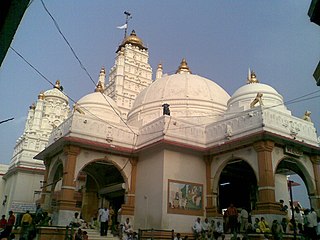
Dakor is a small city and a municipality in Kheda district in the state of Gujarat, India. It is prominent for its grand temple of Shree Ranchhodraiji.
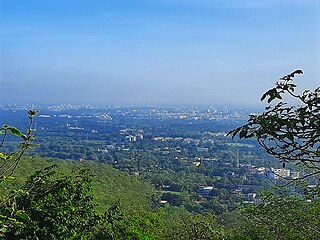
Valsad, historically known as Bulsar, is a city and a municipality in Valsad district of the Indian state of Gujarat. It is the district headquarters of Valsad district.

Kashi Vishwanath Temple is one of the most famous Hindu temples dedicated to Lord Shiva. It is located in Vishwanath Gali of Varanasi, Uttar Pradesh in India. The Temple stands on the western bank of the holy river Ganga, and is one of the twelve Jyotirlingas, or Jyotirlingams, the holiest of Shiva Temples. The main deity is known by the names Shri Vishwanath and Vishweshwara literally meaning Lord of the Universe. Varanasi city was called Kashi in ancient times, and hence the temple is popularly called Kashi Vishwanath Temple. The etymology of the name Vishveshvara is Vishva: Universe, Ishvara: lord, one who has dominion.
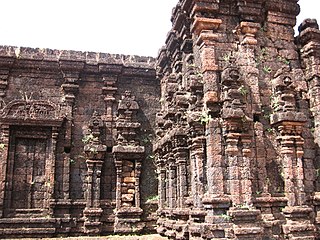
The Rajarajeswara temple is a Shiva temple located in Taliparamba in Kannur district of Kerala, South India. The temple is regarded as one of the existing 108 ancient Shiva Temples of ancient Kerala. It also has a prominent place amongst the numerous Shiva temples in South India. It had the tallest shikhara amongst the temples of its time. The Rajarajeshwara temple has a top of about 90 tonnes. If any problem is encountered in the other temples of South India, devotees seek a solution in this temple through a prasna, a traditional method of astrological decision making. The prasna is conducted on a peedha outside the temple.
Somnath Nagar formally known as Prabhas Patan, also known as Somnath Patan or Prabhas Ksheta, historically named Dev Patan, is an area situated in Veraval, Gir Somnath district in Saurashtra region of Gujarat, India. Somnath temple, a place of pilgrimage due to its importance as Jyotirlinga site dedicated to Shiva, is located here.

Devprayag is a town and a nagar panchayat (municipality) in Tehri Garhwal district in the state of Uttarakhand, India, and is the final one of the Panch Prayag of Alaknanda River where Alaknanda meets the Bhagirathi river and both rivers thereafter flow on as the Ganges river or Ganga.
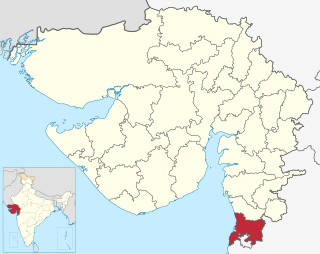
Valsad district, historically known as Bulsar district is one of the 33 districts in the Western Indian state of Gujarat. It is bound by Navsari district to the north, Nashik district of Maharashtra state to the east, and Dadra and Nagar Haveli district of the Dadra and Nagar Haveli and Daman and Diu (DNHDD) union territory and the Palghar district of Maharashtra to the south. The Arabian Sea lies west of the district. The coastal Daman enclave of DNHDD is bounded by Valsad district on the north, east, and south. The district's administrative capital is Valsad. The district's largest city is Vapi.

Kotilingeshwara Temple a temple in the village of Kammasandra in Kolar district, Karnataka, India. The presiding deity of the temple is Lord Shiva. The temple has one of the largest Shivalingams in the world.

Murudeshwara is a town in Bhatkal Taluk of Uttara Kannada district in the state of Karnataka, India. The town is located 13 km from the taluk headquarters of Bhatkal. Murudeshwara is famous for the world's second tallest Shiva statue, the town lies on the coast of the Arabian Sea and is also famous for the Murudeshwara Temple. Murudeshwara has a railway station on the Mangaluru-Mumbai Konkan railway route.
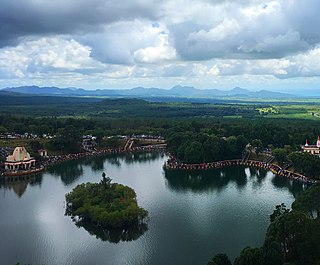
Ganga Talao is a crater lake situated in a secluded mountain area in the district of Savanne, deep in the heart of Mauritius. It is about 550 m (1,800 ft) above sea level. The first group of pilgrims who went to Ganga Talao were from the village of Triolet and it was led by Pandit Giri Gossayne from Terre Rouge in 1898.
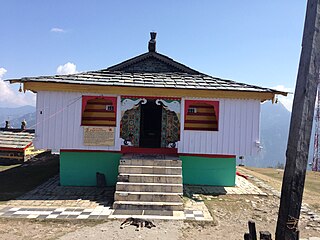
Bijli Mahadev is one of the sacred temples of the Indian state of Himachal Pradesh. It is located at an altitude of about 2,460m in the Kullu Valley. Bijli Mahadev is one of the ancient temples in India and dedicated to Lord Shiva (Mahadev). Located 14 km from Kullu across the Beas river, it can be approached by a rewarding trek of 3 km.
Baneshwar fair is an annual tribal fair held in Dungarpur district in Rajasthan state of India. The fair is held in the month of January or February at Baneshwar, near the confluence of the Som and Mahi rivers. This fair is a major fair in tribal culture and has been described as "the Kumbh mela for the tribals".

Mahadeva Temple, Tambdi Surla is a 12th-century Shaivite temple in the Kadamba style dedicated to Lord Shiva and an active place of Hindu worship. It is an ASI protected Monument of National Importance in Goa.

Bhoramdeo Temple is a complex of Hindu temples dedicated to the Lord Shiva in Bhoramdeo, in the Indian state of Chhattisgarh. It comprises a group of four temples of which the earliest is a brick-temple.

Trikut Pahar (Trikut Hills, is a Hindu pilgrimage situated around 15 km away from the town of Deoghar, on the way to Dumka at Trikut Basdiha in Mohanpur Block of Deoghar District in Jharkhand state, India. There are three main peaks on the hill. The height of this hill is 2470 feet. A rope way is a tourist attraction and can be used to reach the top of the hill. Other than the ropeway, tourists can also use the stairs to reach the top. The hill is covered with clouds in rainy seasons and waterfalls and small streams are visible from July–September. There are views from the top of the mountain and solar panels situated in Tapovan are also visible. Trikut is a tourist spot in Jharkhand state.

The Mahabaleshwar Temple, Gokarna is a 4th-century CE Hindu temple located in Gokarna, Uttara Kannada district, Karnataka state, India which is built in the classical Dravidian architectural style. It is a site of religious pilgrimage. The temple faces the Gokarna beach on the Arabian Sea in which Hindu pilgrims cleanse before visiting the temple for worship. The temple is considered as holy as the Shiva temple at Varanasi or Kāśi (Kashi) in North India on the banks of the Ganges River. Hence, the Mahabaleshwar temple, Gokarna is known as the Dakshin Kasi. The temple deifies the Pranalinga also called Atmalinga or Shiva Linga In legend, it is said that the deity of the temple will bestow immense blessings to devotees, even to those who only glimpse it. Currently the administrative charge of the temple is with Sri Ramachandrapura Mutt, as per the guidance of Adiguru Shankaracharya during the establishment of the Matha.

Koteshwar is a small village and the location of an ancient Shiva temple. It located near the mouth of Kori Creek, in the west of Kutch district of Gujarat, India.

A lingam, sometimes referred to as linga or Shiva linga, is an abstract or aniconic representation of the Hindu god Shiva in Shaivism. It is typically the primary murti or devotional image in Hindu temples dedicated to Shiva, also found in smaller shrines, or as self-manifested natural objects. It is often represented within a disc-shaped platform. Lingayats wear a lingam inside a necklace, called Ishtalinga. It is usually shown with yoni – its feminine counterpart. Together, they symbolize the merging of microcosmos and macrocosmos, the divine eternal process of creation and regeneration, and the union of the feminine and the masculine that recreates all of existence. The lingam is conceptualized both as an emblem of generative and destructive power, particularly in the esoteric Kaula and Tantra practices, as well as the Shaivism and Shaktism traditions of Hinduism.
Gangeshwar Mahadev Temple is also known as Gangeshwar Mahadev or Gangeshwar Temple.It is a Hindu temple dedicated to Lord Shiva (Mahadeva) located at seashore of Fudam Village just 3 km away from Diu near Gujarat. The view of the temple is unique set on the Arabian Sea. This is basically a cave temple situated in the midst of the rocks on the seashore. Once pilgrims enter the cave Lord Ganesha, Lord Vishnu, and Goddess Lakshmi can be sight then five shivalingas could visible in different sizes in middle of the sea water, this is the very significant feature of the temple and above the rock the Shiva Linga Seshanag was carved to look out for the Shiva Linga. These lingas are generally submerged in the sea during high tides and only during the low tides chance to visible. This temple is also known as 'Seashore Temple' as Shiva Linga is situated on the seashore.

















